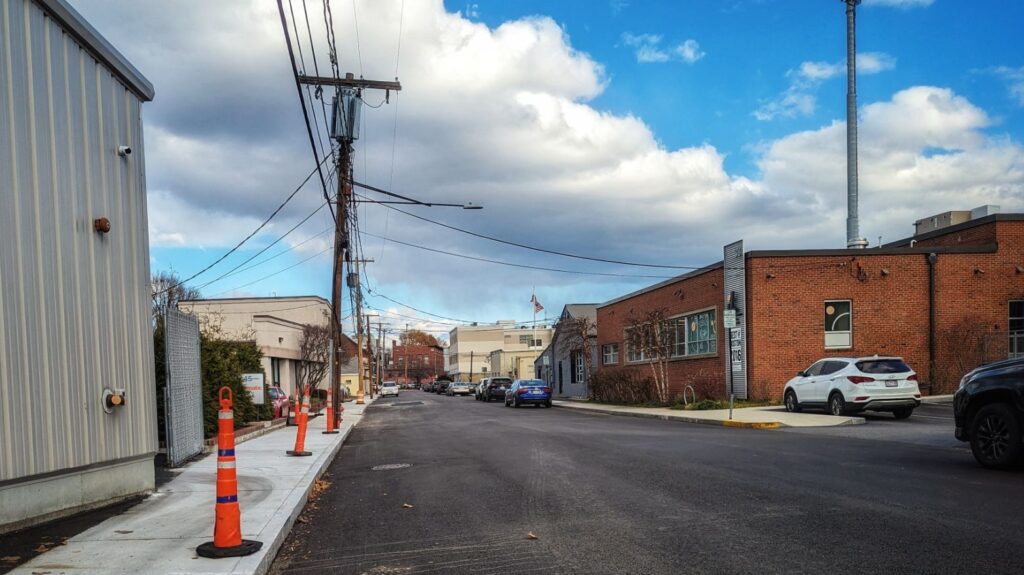BorderStreetPic2
The hope of up-zoning Border Street has risen and dissipated—much like the water that briefly engulfs it after a heavy rain—and on Wednesday night that hope rose again and flowed into a nearly unanimous vote in its favor.
During the third night of deliberations on the Village Center Overlay District plan, the City Council passed an amendment to add Border Street lots to VC3 and VC2 zones (those designations allow the highest density in the plan).
The vote was 22 in favor and two against with Julia Malakie, the ward councilor for Border Street, and Ward 2 Councilor Emily Norton voting against it.
Back and forth…
The Border Street parcels were originally part of the Village Center Overlay District plan. But in a later version they were taken out, after some councilors raised concerns about flooding on that street.
Since then, councilors have said they were misled, that there wasn’t enough information, and that it was late at night when they took the lots off the up-zoning plan during a Zoning and Planning meeting earlier this year.
On Nov. 20, Councilor Andrea Kelley motioned to have the Border Street lots added back to the plan, noting that up-zoning what the business property owners on the street have said they want.
But Kelley’s amendment was tabled. And that got a lot of people talking about Border Street.
Earlier this week, DPW Commissioner Jim McGonagle spoke with The Newton Beacon about the source of the flooding and potential ways to pursue fixing it.
It turns out a pipe installed by the Massachusetts Water Resource Authority a long time ago was shoved through a city culvert—with the city’s permission, no less—cutting the culvert’s water flow capacity in half.

An engineering firm is working on a hydraulics study that’s expected to take a few months to complete. Once that’s done, the city can go to the state to negotiate a fix. That could take a while.
But the city has to comply with the MBTA Communities Act and up-zone areas around MBTA stops by Dec. 31. And Border Street, which is near the West Newton MBTA station, would add about 450 potential housing units to the count required by that new state law.
McGonagle also said that redeveloping any street could help alleviate flooding, since new developments are subject to stormwater mitigation rules that don’t apply to the current older buildings.
… And back again
And on Wednesday night, the Border Street amendment came up for round two.
“It’s to be consistent with the goals of helping our local businesses, increasing housing and improving deteriorating conditions,” Kelley said in re-introducing it. “Even some of the owners along this street refer to this as ‘one of the armpits of Newton.’”
Councilor Deb Crossley—chair of the Zoning and Planning and one of three incumbents voted out earlier this month in an election centered around the rezoning plan—pointed to the Beacon story in her statements.
“The zoning has nothing to do with the flooding. The flooding has nothing to do with the zoning,” Crossley said. “And it was used as a ruse to get us to—and we did—take it out of the plan.”
Crossley said that flooding concerns can be used to delay or prevent construction, so no one can redevelop Border Street until the flooding situation is resolved.
Councilor John Oliver initially wanted to wait until the flooding is fixed and then add Border Street to the village center overlay map. But after the discussion, he ended up voting in favor of the motion, while maintaining his concerns about the flooding.
“Because we know this street will flood again,” Oliver said. “And it will continue to flood until we fix the problem.”
Leveraging lots
Border Street was an opportunity for some to strike a deal.
Malakie proposed leaving Border Street out of the rezoning plan so that the city could wave the potential for Border Street up-zoning in front of the state to entice the state to come fix the problem pipe.
“We can tell the state, ‘Look, if you help us solve the problem, you’ll get more housing in Newton that you want,’” Malakie said. “So that gives the state more of an incentive to lean on the MWRA to try to fix the problem.”
Councilor Marc Laredo expressed his support for adding Border Street, saying, “Of all the areas we’re talking about doing potential redevelopment in this city, this strikes me as an appropriate area to do it.”
He then mentioned compromise and an upcoming amendment to reduce building height allowances in West Newton.
Councilor Leonard Gentile initially said he’d vote against it Wednesday but would be open to supporting it after he gets reductions he wants in other parts of the city, primarily West Newton.
Gentile also said he was filing a docket item for a future meeting for the Council to discuss the best uses for Border Street and other manufacturing districts with planning officials.
“So I’m going to vote against it this time, but I could be convinced, later on in this process as part of a compromise, that we should do it, as long as we follow through on the docket item I’m talking about,” he said.
Support for Border Stret up-zoning seemed to swell during the discussion, and at the end of the debate, Gentile rose to announce he was “changing course” and would vote in favor of it—because he was trusting his colleagues to “give concessions on other amendments.”
The City Council is set to enter a fourth night of debate, and potentially a vote, on the Village Center Overlay District on Monday.